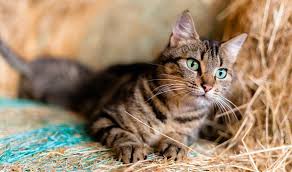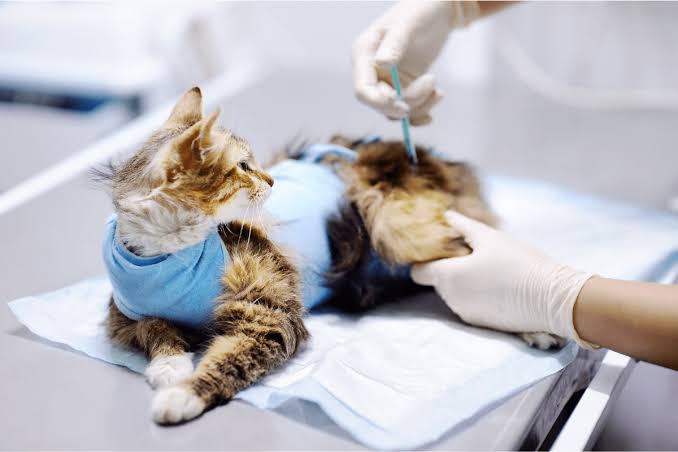Feline Leukemia, also known by its scientific name FeLV (Feline Leukemia Virus), is a serious and contagious disease that affects cats. This viral infection specifically targets a cat’s immune system, leaving them vulnerable to various other infections and diseases.
FeLV is primarily spread through close contact between infected cats. This can occur through mutual grooming, bites, or sharing of food and water bowls. Kittens can contract the virus from their infected mothers during birth or through nursing.
Once a cat is infected with FeLV, the virus can take residence in the bone marrow, lymphoid tissues, and other organs. This can lead to a weakened immune system, making the cat susceptible to a range of health issues. Common complications include anemia, respiratory infections, and the development of certain cancers.
The symptoms of Feline Leukemia can vary widely. Some cats may show no visible signs for an extended period, while others may display symptoms like weight loss, lethargy, swollen lymph nodes, and poor coat condition. It’s important for cat owners to observe any changes in their pet’s behavior and seek veterinary attention if they suspect FeLV.
Unfortunately, there is no cure for Feline Leukemia. However, supportive care can help manage symptoms and improve a cat’s quality of life. Regular veterinary check-ups are crucial for monitoring the health of infected cats and addressing any emerging issues promptly.
Prevention plays a key role in managing FeLV. Vaccination is available and is recommended for cats at risk of exposure, especially those that spend time outdoors or live with infected cats. Testing for FeLV is also an essential part of routine veterinary care, allowing early detection and intervention.
Feline Leukemia, scientifically known as FeLV, is a viral infection affecting cats, compromising their immune system and leaving them susceptible to various health issues. While there is no cure, preventive measures such as vaccination and regular testing are crucial for managing and controlling the spread of this serious disease. If you suspect your cat may be infected, prompt veterinary care is essential for a comprehensive assessment and appropriate management.
Read Also: Fattening of Sheep and Goats Guide
Animals Affected by Feline Leukemia (FeLV)

Feline Leukemia (FeLV) primarily affects domestic cats, and its impact extends to various breeds and ages. The virus poses a threat to both young kittens and adult cats. Cats that engage in outdoor activities or live in multi-cat households are particularly at risk due to the increased likelihood of close contact and transmission.
The virus affects a cat’s immune system, making them more susceptible to secondary infections and diseases. Commonly observed complications in cats with Feline Leukemia include respiratory infections, dental issues, anemia, and reproductive problems.
It’s important to note that while domestic cats are the primary hosts for FeLV, other feline species like cheetahs and cougars can also be affected by related viruses. However, the specific strains and impact on non-domestic cats may differ.
Animals in shelters or rescue facilities may be at an elevated risk of exposure due to the close living quarters and potential for interaction with infected cats. Responsible testing and vaccination programs in such environments are crucial for managing the spread of Feline Leukemia.
However, domestic cats, particularly those in multi-cat environments or with outdoor exposure, are the primary animals affected by Feline Leukemia. The virus can impact cats of various breeds and ages, leading to a range of health complications. Additionally, related viruses may affect some non-domestic feline species, emphasizing the importance of responsible care and prevention measures in various settings.
Damages Caused by Feline Leukemia
Feline Leukemia (FeLV) can cause a range of damages to a cat’s health, affecting various organs and systems due to its impact on the immune system. Some of the damages caused by Feline Leukemia include:
1. Weakened Immune System: FeLV attacks the immune system, compromising the cat’s ability to defend against infections. This weakened immunity makes them susceptible to a variety of illnesses, ranging from respiratory infections to more severe conditions.
2. Anemia: The virus can affect the bone marrow, leading to a decrease in the production of red blood cells. Anemia can result in lethargy, weakness, and pale mucous membranes.
3. Reproductive Issues: Female cats infected with FeLV may experience reproductive problems, including difficulties during pregnancy, stillbirths, or giving birth to weak kittens. Male cats may have reduced fertility.
4. Respiratory Problems: Cats with Feline Leukemia are prone to respiratory infections, which can cause symptoms like coughing, sneezing, and nasal discharge.
5. Oral Health Issues: Dental problems are common in cats with FeLV. This includes gum disease, tooth decay, and oral infections, which can lead to discomfort and difficulty eating.
6. Lymphoma and Other Cancers: FeLV increases the risk of certain cancers, especially lymphoma. Tumors can develop in the lymph nodes and other organs, further compromising the cat’s health.
7. Neurological Disorders: In some cases, FeLV may affect the central nervous system, leading to neurological symptoms such as seizures, imbalance, and changes in behavior.
8. Shortened Lifespan: While not an immediate cause of death, Feline Leukemia can significantly shorten a cat’s lifespan due to the increased susceptibility to various health issues.
It’s crucial to recognize that there is currently no cure for Feline Leukemia. However, supportive care, early detection of complications, and preventive measures such as vaccination can help manage the damages caused by the virus and improve the cat’s quality of life. Regular veterinary check-ups are essential for monitoring and addressing emerging health issues in cats with FeLV.
Read Also: Methods of Castration in Sheep and Goat
Control and Preventive Measures

Controlling and preventing the spread of Feline Leukemia (FeLV) involves a combination of measures to protect both individual cats and the feline population at large. Here are key control and preventive measures:
1. Vaccination: Vaccination is a crucial tool in preventing FeLV infection. Cats at risk, especially those with outdoor access or living in multi-cat households, should receive the FeLV vaccine. Discussing vaccination schedules with a veterinarian is essential for tailored preventive care.
2. Testing and Screening: Regular testing for FeLV is important, especially for cats with potential exposure risks. Testing is recommended for new additions to a household, cats with unknown health histories, and those showing signs of illness. Early detection allows for timely intervention and management.
3. Isolation of Infected Cats: If a cat is diagnosed with FeLV, it’s crucial to isolate them from uninfected cats to prevent further transmission. This includes separate feeding and grooming arrangements.
4. Responsible Breeding Practices: Breeders should routinely test breeding cats for FeLV to prevent the transmission of the virus to kittens. Kittens born to FeLV-positive mothers may be at risk and should be carefully monitored.
5. Reducing Outdoor Exposure: Limiting a cat’s outdoor activities, especially if they are not vaccinated against FeLV, can help minimize the risk of exposure to the virus. Indoor living provides a controlled environment that reduces contact with potentially infected cats.
6. Hygiene and Sanitation: Maintaining a clean environment is essential for preventing the spread of FeLV. Regular cleaning of litter boxes, food and water bowls, and other shared spaces helps reduce the risk of transmission through saliva, urine, or feces.
7. Promoting Individual Health: Keeping cats in good overall health can help them resist infections, including FeLV. Providing a balanced diet, regular veterinary check-ups, and prompt treatment of any health issues contribute to a stronger immune system.
8. Educating Cat Owners: Educating cat owners about the risks and preventive measures associated with Feline Leukemia is crucial. This includes awareness of the importance of vaccinations, testing, and responsible care practices.
By combining these measures, it’s possible to control the spread of Feline Leukemia and reduce its impact on the feline population. Implementing preventive strategies not only protects individual cats but also contributes to the overall health and well-being of the community of cats in a given environment.
Frequently Asked Questions (FAQs) About Feline Leukemia (FeLV)
1. Q: What is Feline Leukemia (FeLV)?
A: Feline Leukemia, or FeLV, is a viral infection that affects cats. It compromises the immune system, making them more susceptible to various infections and health issues.
2. Q: How is FeLV transmitted?
A: FeLV is primarily spread through close contact with infected cats. This can occur through grooming, bites, or sharing food and water bowls. Kittens can also contract it from their infected mothers.
3. Q: Are all cats at risk of FeLV?
A: While all cats are susceptible, those with outdoor exposure or living in multi-cat households are at a higher risk due to increased chances of close contact and transmission.
4. Q: What are the symptoms of Feline Leukemia?
A: Symptoms can vary, but common signs include weight loss, lethargy, swollen lymph nodes, poor coat condition, and respiratory issues. Some infected cats may show no visible signs for an extended period.
5. Q: Is there a cure for Feline Leukemia?
A: Unfortunately, there is no cure for FeLV. Treatment focuses on managing symptoms and providing supportive care to improve the cat’s quality of life.
6. Q: Can Feline Leukemia be prevented?
A: Yes, prevention measures include vaccination, regular testing, and responsible breeding practices. Limiting outdoor exposure and maintaining good hygiene also help reduce the risk of transmission.
7. Q: Should I test my cat for FeLV?
A: Testing is recommended for cats with unknown health histories, new additions to a household, or those showing signs of illness. Regular testing can help with early detection and intervention.
8. Q: Can FeLV affect other animals?
A: Feline Leukemia primarily affects domestic cats. While related viruses may impact some non-domestic feline species, the specific strains and impact can differ.
9. Q: What should I do if my cat is diagnosed with FeLV?
A: If your cat is diagnosed, work closely with your veterinarian to develop a management plan. This may include isolation from uninfected cats, supportive care, and regular veterinary check-ups.
10. Q: Is it safe to adopt a cat with FeLV?
A: Adopting a cat with FeLV requires careful consideration. These cats can live fulfilling lives with proper care, but it’s important to understand the challenges and commitment involved in managing their health.

